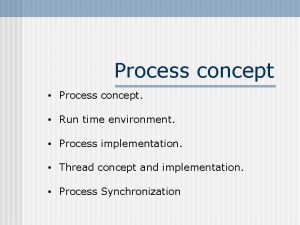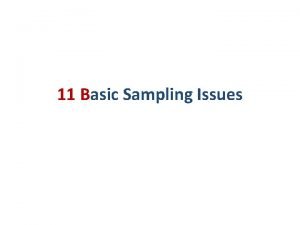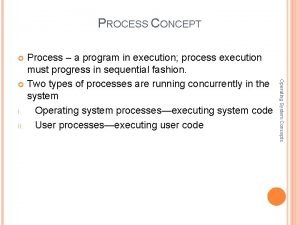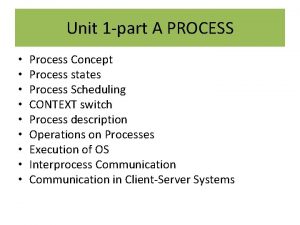Sampling Concept Of Sampling Sampling is the process








































- Slides: 40

Sampling

Concept Of Sampling • Sampling is the process of selecting a few (a sample) from a bigger group to become the basis for estimating or predicting the prevalence of an unknown piece of information, situation or outcome regarding the bigger group. • A sample is a subgroup of the population you are interested in

• This process of selecting a sample from the total population has advantages and disadvantages. • The advantages are that it saves time as well as financial and human resources. • The disadvantage is that you do not find out the information about the population’s characteristics of interest to you but only estimate or predict them. Hence, the possibility of an error in your estimation exists.

Sampling Terminology Suppose you want to estimate the average of the students in your class. • The class, from which you select your sample are called the study population, and are usually denoted by the letter N • The small group of students, from whom you collect the required information to estimate the average of the class, is called the sample.

• The number of students, from whom you obtain the required information is called the sample size and is usually denoted by the letter n. • The way you select students, is called the sampling design or sampling strategy. • Each student, that becomes the basis for selecting your sample is called the sampling unit or sampling element.

• A list identifying in the study population is called the sampling frame. If all elements in a sampling population cannot be individually identified, you cannot have a sampling frame for that study population. • Your findings based on the information obtained from your respondents (sample) are called sample statistics. Your sample statistics become the basis of estimating the prevalence of the above characteristics in the study population.

• Your main aim is to find answers to your research questions in the study population, not in the sample you collected information from. • From sample statistics we make an estimate of the answers to our research questions in the study population. The estimates arrived at from sample statistics are called population parameters or the population mean.

Three questions to ask Ø Whom? Ø People, animal, records …. Ø Inclusion and exclusion criteria Ø How many? Ø Census( Total coverage)? Ø Sample size calculation Ø How?

Sample strategy • From whom should you seek data? • Where and when? • How large should your sample be?

Study Population • Population: entire group of people living within certain geographical boundaries… • Study population: The group of individual units to be investigated… – They may be persons, families, records, certificates, clinics, schools… • Sample: a study sample is the number of study units we would like to study….

How many subjects?

The calculation of sample size • Basically, it depends on what you want to do with the findings and what type of relationships you want to establish • Your purpose in undertaking research is the main determinant of the level of accuracy required in the results, and this level of accuracy is an important determinant of sample size

• In determining the size of your sample you need to consider the following: • At what level of confidence do you want to test your results? • With what degree of accuracy do you wish to estimate the population parameters? • What is the estimated level of variation (standard deviation), with respect to the main variable you are studying, in the study population?

The level of confidence or risk: 95% or 99% or 90% CI The level of precision (sampling error) 60% ± 5% or 10% or … The degree of variability in the attributes: 0. 5 gives the largest sample size

Strategies for determining sample size 1. Using a census for small population? ? Useful in case of small population, 200 or less. 2. Imitating a sample size of similar studies Review carefully the procedures through literature review, and where the study has been published? 3. Using software programs like Open-epi-calculator 4. Using formulas

5. Using published tables or guides


How to sample? § Definition of study population and target population § Selection of a sampling frame (list) § Decide about probability or nonprobability sampling

Principles of Sampling Principle 1 – in a majority of cases of sampling there will be a difference between the sample statistics and the true population mean, which is attributable to the selection of the units in the sample. Principle 2 – the greater the sample size, the more accurate the estimate of the true population mean. Principle 3 – the greater the difference in the variable under study in a population for a given sample size, the greater the difference between the sample statistics and the true population mean.

Aims In Selecting a Sample • When select a sample; we are aiming to achieve maximum precision in our estimates within a given sample size, and avoid bias in the selection of the sample.

Types of sampling method Sampling methods Probability samples Non-probability samples Simple random Systematic random Quota Convenience Cluster Stratified Snowball Judgement

Types of sampling 1. Random/independent probability sampling designs • each element in the population has an equal and independent chance of selection in the sample • Equal implies that the probability of selection of each element in the population is the same; that is, the choice of an element in the sample is not influenced by other considerations such as personal preference. • The concept of independence means that the choice of one element is not dependent upon the choice of another element in the sampling; that is, the selection or rejection of one element does not affect the inclusion or exclusion of another

• There are two main advantages of random/probability samples: 1. As they represent the total sampling population, the inferences drawn from such samples can be generalized to the total sampling population. 2. Some statistical tests based upon theory of probability can be applied only to data collected from random samples. Some of these tests are important for establishing conclusive correlations.

Specific random/probability sampling designs 1. 2. 3. 4. Simple random sampling (SRS) Systematic Stratified random sampling Cluster sampling

Simple Random Sampling • Assures each element in the population has an equal chance of being included in the sample…

methods that you can adopt to select a random sample The three most common are: 1. The fishbowl draw – if your total population is small, an easy procedure is to number each element using separate slips of paper for each element, put all the slips into a box and then pick them out one by one without looking, until the number of slips selected equals the sample size you decided upon. This method is used in some lotteries. 2. Computer program – there a number of programs that can help you to select a random sample. 3. A table of randomly generated numbers

Systematic random sample • Prepare a list of the elements of all study population N • Decide on the sample size n • Determine the width of the interval = total population/ sample size (N/n) • Using SRS select an element from the first interval • Select the same order element from each subsequent interval


Stratified sampling Sub-samples are randomly drawn from samples within different strata that are more or less equal on some characteristic Why? Can reduce random error Proportional representation of population How? • Identify variable(s) for stratification • Complete list of population elements must be obtained • Use randomization to take a simple random sample from each stratum



Cluster sampling • if the population is large, as in the case of a city, state or country, it becomes difficult and expensive to identify each sampling unit. In such cases the use of cluster sampling is more appropriate. • Cluster sampling is based on the ability of the researcher to divide the sampling population into groups (based upon visible or easily identifiable characteristics), called clusters, • then to select elements within each cluster, using the SRS technique. • Clusters can be formed on the basis of geographical proximity or a common characteristic that has a correlation with the main variable of the study (as in stratified sampling). • Depending on the level of clustering, sometimes sampling may be done at different levels. These levels constitute the different stages (single, double or multiple) of clustering,


Non-probability sampling designs • do not follow theory of probability in the choice of elements from the sampling population. • are used when the number of elements in a population is either unknown or cannot be individually identified. In such situations the selection of elements is dependent upon other considerations.

• There are five commonly used non-random designs, each based on a different consideration, which are commonly used in both qualitative and quantitative research. These are: • 1. quota sampling; • 2. convenience sampling; • 3. judgmental sampling or purposive sampling; • 4. expert sampling; • 5. snowball sampling.

Quota sampling • The main consideration directing quota sampling is the researcher’s ease of access to the sample population. • In addition to convenience, you are guided by some visible characteristic, such as gender or race, of the study population that is of interest to you. • The sample is selected from a location convenient to you as a researcher, and whenever a person with this visible relevant characteristic is seen that person is asked to participate in the study. • The process continues until you have been able to contact the required number of respondents (quota).

Convenience sampling • Find some people that are easy to find

Purposive sampling • The primary consideration is your judgment as to who can provide the best information to achieve the objectives of your study. • You as a researcher only go to those people who in your opinion are likely to have the required information and be willing to share it with you. • This type of sampling is extremely useful when you want to construct a historical reality, describe a phenomenon or develop something about which only a little is known. • This sampling strategy is more common in qualitative research,

Expert sampling • The only difference between judgmental sampling and expert sampling is that your respondents must be known experts in the field of interest to you. • This is again used in both types of research but more so in qualitative research studies

Snowball sampling • It is a process of selecting a sample using networks. • To start with, a few individuals in a group or organization are selected and the required information is collected from them. • They are then asked to identify other people in the group or organization, and the people selected by them become a part of the sample. • Information is collected from them, and then these people are asked to identify other members of the group and, in turn, those identified become the basis of further data collection. • This process is continued until the required number or a saturation point has been reached.
 Probability sampling vs non probability sampling
Probability sampling vs non probability sampling Objectives of sampling
Objectives of sampling Types of probability sampling
Types of probability sampling Contoh rancangan observasi psikologi
Contoh rancangan observasi psikologi Stratified sampling vs cluster sampling
Stratified sampling vs cluster sampling Sampling definition
Sampling definition Natural sampling vs flat top sampling
Natural sampling vs flat top sampling Hình ảnh bộ gõ cơ thể búng tay
Hình ảnh bộ gõ cơ thể búng tay Lp html
Lp html Bổ thể
Bổ thể Tỉ lệ cơ thể trẻ em
Tỉ lệ cơ thể trẻ em Chó sói
Chó sói Chụp tư thế worms-breton
Chụp tư thế worms-breton Bài hát chúa yêu trần thế alleluia
Bài hát chúa yêu trần thế alleluia Môn thể thao bắt đầu bằng chữ đua
Môn thể thao bắt đầu bằng chữ đua Thế nào là hệ số cao nhất
Thế nào là hệ số cao nhất Các châu lục và đại dương trên thế giới
Các châu lục và đại dương trên thế giới Công của trọng lực
Công của trọng lực Trời xanh đây là của chúng ta thể thơ
Trời xanh đây là của chúng ta thể thơ Cách giải mật thư tọa độ
Cách giải mật thư tọa độ Phép trừ bù
Phép trừ bù độ dài liên kết
độ dài liên kết Các châu lục và đại dương trên thế giới
Các châu lục và đại dương trên thế giới Thể thơ truyền thống
Thể thơ truyền thống Quá trình desamine hóa có thể tạo ra
Quá trình desamine hóa có thể tạo ra Một số thể thơ truyền thống
Một số thể thơ truyền thống Cái miệng nó xinh thế chỉ nói điều hay thôi
Cái miệng nó xinh thế chỉ nói điều hay thôi Vẽ hình chiếu vuông góc của vật thể sau
Vẽ hình chiếu vuông góc của vật thể sau Nguyên nhân của sự mỏi cơ sinh 8
Nguyên nhân của sự mỏi cơ sinh 8 đặc điểm cơ thể của người tối cổ
đặc điểm cơ thể của người tối cổ Ví dụ về giọng cùng tên
Ví dụ về giọng cùng tên Vẽ hình chiếu đứng bằng cạnh của vật thể
Vẽ hình chiếu đứng bằng cạnh của vật thể Phối cảnh
Phối cảnh Thẻ vin
Thẻ vin đại từ thay thế
đại từ thay thế điện thế nghỉ
điện thế nghỉ Tư thế ngồi viết
Tư thế ngồi viết Diễn thế sinh thái là
Diễn thế sinh thái là Các loại đột biến cấu trúc nhiễm sắc thể
Các loại đột biến cấu trúc nhiễm sắc thể Số nguyên tố là số gì
Số nguyên tố là số gì Tư thế ngồi viết
Tư thế ngồi viết
































































